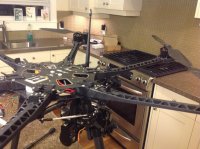Europe uses 900 Mhz cell phone frequencies extensively (called GMS or GSM) but North America has moved away from 900 Mhz for cell phone communication.
Regardless of the frequencies cell phone towers use, the high wattage transmitters will stamp all over lower wattage radios that are tooooo close by due to harmonics and spurious emissions etc.
Other users of 900 Mhz include the Armed Forces, Oil and Gas Industries, Pipeline industries, Turnpike toll booth and monitoring sites etc.
From my investigation the Belkin 9000 seems to be an audiophile audio cable or USB signal cable! We were talking about a coax cable to extend the antenna away from the radio transceiver.
For that you require a system matched radio coax which is 50 ohms impedance for this radio and antenna..... hence RG58 or RG59 radio system standards. Best to complete HAM radio course before one goes there!!
Thanks for reply...in an attempt to boost voltage..I have a 5 volt "dumb" usb charger up on the tripod with the supplied USB pigtail plugged into that.That should eliminate voltage drop over 10 cable run as it is up by the transmitter.Your suggustion of data signal drop out over the extended run has merit..I will test that out by moving lmk 900 unit off the tripod and just use the supplied usp cable.Remember rg58 is really lossy at high frequencys...something in the Belkin 9000 series double shielded cable would be better.One issue is that our flying site is close to a cell phone tower and comments by another operator was that 900 mhz didnt work too well there..maybe I should have been closer...linear amps in the 3 to 5 watt range are expensive...and of course require amatuer license..more later after testing...a high gain yagi would be best but would require an antenna tracker though..kp couch


